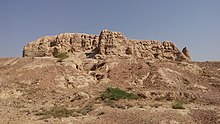Bannu
The major industries of Bannu are cloth weaving, sugar mills[8] and the manufacturing of cotton fabrics, machinery and equipment.
[11] During the 6th century BCE, the basin around Bannu was known as Sattagydia (Old Persian: 𐎰𐎫𐎦𐎢𐏁 Thataguš, country of the "hundred cows").
The history of Bannu goes back to prehistoric time, due to its strategic location along the Kurram and Tochi routes which lead into the Indus Valley.
[12] Recent archaeological excavations at Akra, Bannu showed that it was a large urban site that existed throughout the Iron Age and had trade relations with Central Asia.
[13] The sacred texts of Zend Avesta and Vendidad mentions Varəna, the Avestan predecessor of the name for Bannu, as the 14th in the list of the "16 perfect lands" created by Ahura Mazda.
[11] According to the Avesta, Varəna was the homeland and birthplace of the legendary King Fereydun (known in Avestan as Θraētaona, and also known as Āθβiiāni, "of the house of Abtin").
After the decline of Mauryan Empire, the region fell under the administrative and political control of Indo-Greeks, Indo-Scythian and Indo-Parthians successively.
In the Tochi Valley of North Waziristan near Bannu, Bactrian language inscriptions originally written in the 9th century have been discovered.
[16] The city was renamed in 1848 by Herbert Benjamin Edwardes, a lieutenant in the 1st Bengal European Fusiliers Regiment of the East India Company's private army.
[18] Bannu was used as the base of operations for all punitive expeditions undertaken by detachments of the British Indian Army to the Tochi Valley and the Waziristan frontier.
Mullick graduated from Banaras Engineering College[20] and had served in Iraq and Lahore as an expert in heavy earth-moving equipment before the independence of Pakistan in 1947.
The fort, erected at the same time, bore the name of Dhulipgarh (Dalipgarh), in honour of the Maharaja of Lahore; and the bazar was also known as Dhulipnagar (Dalipnagar).
The profuse irrigation and insufficient drainage of the surrounding fields render Bannu an unhealthy station.
Bannu possesses a dispensary and two high schools, a public library and a town hall known as the Nicholson Memorial.
[48][49] The oldest and most renowned public sector institution is Government Post-Graduate College Bannu, which started operating in 1951.



